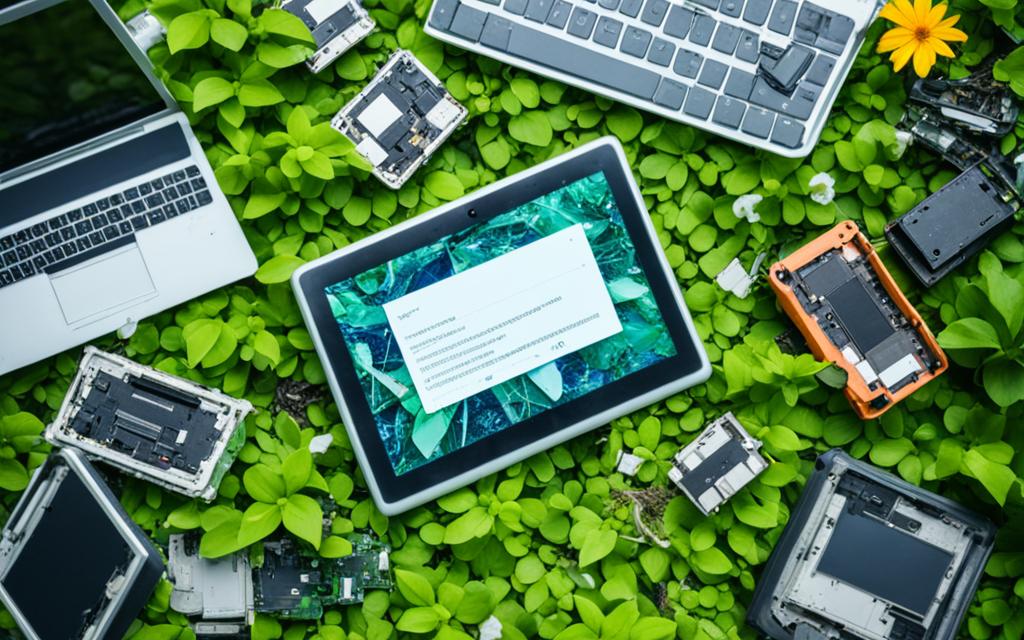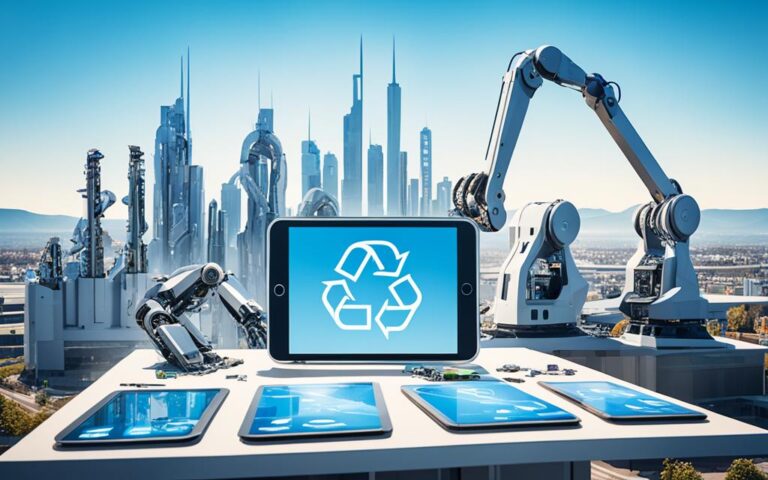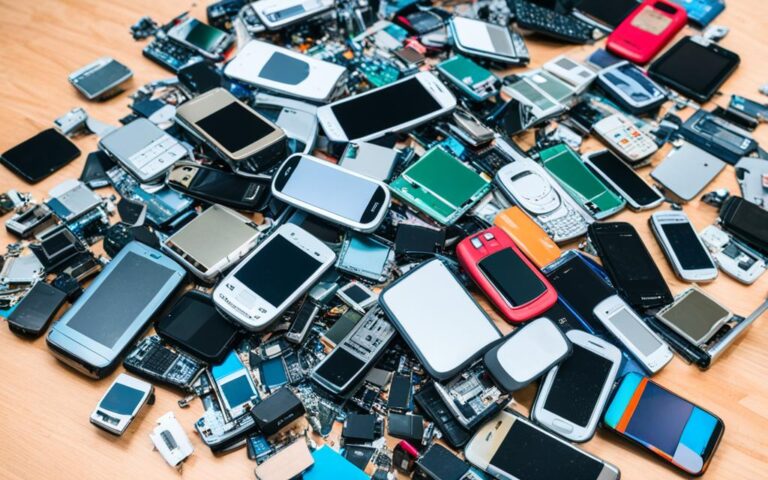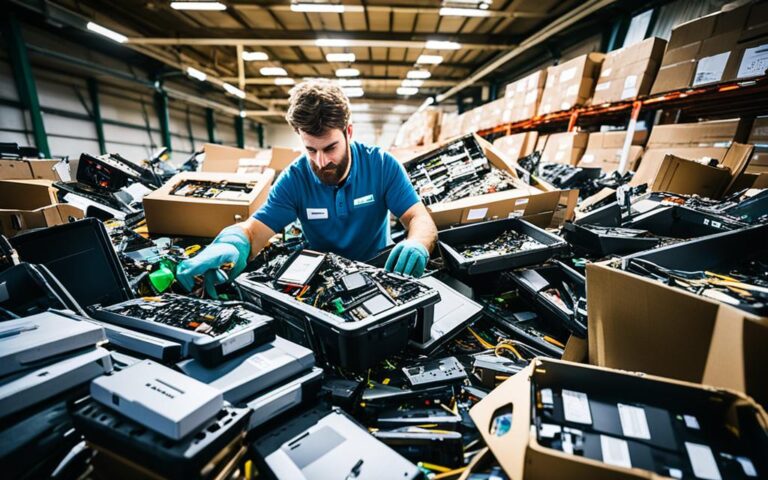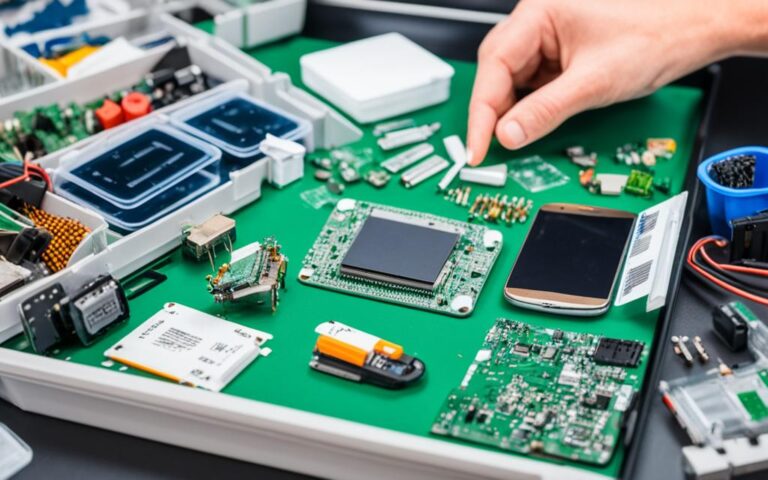Tablet Lifespan: When to Recycle and Upgrade
Welcome to our insightful guide on tablet lifespan, recycling, and upgrading. Tablets have revolutionized the way we work, communicate, and consume media. With brands like Apple leading the market, tablets have become an integral part of our daily lives. However, as technology advances at a lightning pace, it’s crucial to understand when it’s time to recycle your tablet and upgrade to a newer model.
Recycling your old tablet is not only an environmentally responsible decision, but it also allows you to optimize its performance and ensure compatibility with the latest software updates and apps. By recycling your tablet early, you can unlock its value potential by reselling or refurbishing it for further use.
For businesses that rely on fleets of tablets, proper tablet recycling is even more important. It helps companies save money and promotes sustainability by minimizing electronic waste.
Join us on this sustainable journey as we explore the lifespan of tablets, the environmental impact of e-waste, and strategies for proper tablet recycling. Together, we can make a positive difference and embrace a greener future.
The Lifespan of Different Electronic Devices
When it comes to electronic devices, understanding their lifespan is crucial for making informed decisions about recycling and upgrading. Different devices have varying lifespans, and knowing these can help you plan your technology investments more effectively.
Let’s take a closer look at the average lifespans of various electronic devices:
| Device | Lifespan |
|---|---|
| Desktop Computer | 3-5 years |
| Laptop | 3-5 years |
| Smartphone | 3-5 years |
| Tablet | 7 years |
| Printer | 3-5 years |
| Smart TV | 4-10 years |
| Gaming Console | 6 years |
As seen in the table above, desktop computers, laptops, and smartphones typically provide peak performance for 3 to 5 years before users consider upgrading. Tablets have a longer average lifespan of 7 years, making them more durable in comparison. Printers fall within the same 3 to 5-year range, while smart TVs have longer lifespans, lasting between 4 to 10 years. Gaming consoles are usually used for an average of 6 years before being replaced.
When these devices reach the end of their lifespan, it’s crucial to consider the environmental impact and proper disposal methods. Responsible recycling practices can help minimize e-waste and preserve our planet’s resources.
Note: Insert relevant quote here, if available.
Remember, the lifespan of electronic devices can vary depending on usage, maintenance, and advancements in technology. It’s always a good idea to stay informed about the latest trends and upgrades to make the most sustainable and cost-effective choices for your electronic devices.
The Environmental Impact of Electronic Devices
Electronic devices, when improperly disposed of, can contribute to the growing e-waste problem. Many of these devices contain toxic chemicals that can harm the environment if they end up in landfills or are incinerated.
“Proper disposal and recycling of electronic waste is essential to protect the environment and human health.” – Environmental Expert
Devices like desktop monitors, laptops, and smartphones contain hazardous materials such as lead, mercury, and cadmium. When these materials seep into the soil and groundwater, they pose a significant threat to ecosystems and human well-being.
In addition, the demand for lithium batteries found in smartphones and tablets is depleting finite resources and causing environmental concerns.
Responsible Electronics Recycling
Recycling electronic devices is crucial to minimize their environmental impact. By recycling, valuable materials can be recovered and reused, reducing the need for new resource extraction and manufacturing.
Proper recycling also ensures that any toxic components are safely disposed of and do not harm the environment. It’s essential to choose recycling services that follow environmentally sound practices and adhere to local regulations.
Takeaway: Device longevity and responsible recycling practices go hand in hand in promoting sustainability and reducing e-waste. By understanding the lifespan of electronic devices and making informed choices, we can contribute to a greener future.
Environmental Concerns and Recycling Benefits
The rapid turnover and disposal of electronic devices contribute to the growing e-waste problem. Many of these devices, such as LCD desktop monitors, laptops, and smartphones, contain toxic chemicals that can harm the environment if not properly disposed of. Additionally, the demand for lithium batteries in devices like smartphones and tablets is depleting the earth’s resources and causing environmental implications.
Recycling these devices allows for the recovery of valuable materials and reduces pollution. By recycling electronic devices, we can minimize their impact on the environment and promote sustainability. The benefits of recycling electronic devices, including tablets, extend beyond environmental considerations.
“Recycling electronic devices contributes to the preservation of our planet and ensures a better future for generations to come.” – GreenTech Recycling Solutions
The Environmental Implications of E-Waste
E-waste refers to electronic devices that have reached the end of their lifespan and are discarded. When these devices end up in landfills, they can release toxic chemicals such as lead, mercury, and cadmium into the environment. These substances can contaminate soil, waterways, and air, posing serious threats to human health and ecosystems. Proper recycling of e-waste prevents these toxic chemicals from polluting our environment.
Lithium Batteries and Depletion of Resources
Devices like smartphones and tablets heavily rely on lithium batteries, which are essential for their functionality and portability. However, the extraction and production of lithium batteries require significant amounts of resources, including water, metal ores, and fossil fuels. The continuous demand for lithium batteries contributes to resource depletion and adversely affects the environment.
Moreover, improper disposal of lithium batteries can be hazardous as they may leak toxic chemicals into the soil and water, further exacerbating environmental damage. Recycling these batteries allows for the recovery of valuable materials such as lithium, cobalt, and nickel, reducing the need for raw material extraction and minimizing environmental impact.
Benefits of Recycling Electronic Devices
Recycling electronic devices, including tablets, offers several benefits for individuals and the environment:
- Reduces landfill waste: Proper recycling keeps electronic devices out of landfills, minimizing the release of toxic chemicals and reducing waste.
- Conserves resources: Recycling allows for the recovery and reuse of valuable materials, conserving resources and reducing the need for new raw material extraction.
- Prevents pollution: Recycling reduces the environmental impact by preventing the release of toxic substances into the environment.
- Energy savings: Recycling electronic devices requires less energy compared to manufacturing new devices from scratch.
- Promotes sustainability: By recycling electronic devices, we contribute to a circular economy and promote sustainable practices.
| Environmental Benefits | Social Benefits |
|---|---|
| Reduces pollution and toxic chemical exposure | Promotes environmental awareness |
| Conserves natural resources | Creates job opportunities in the recycling industry |
| Reduces greenhouse gas emissions | Preserves biodiversity |
Recycling electronic devices is not only an environmental responsibility but also a collective effort to build a more sustainable future. By choosing to recycle our electronic devices, including tablets, we can make a positive impact on the environment and contribute to a greener, cleaner world.
Sustainable Strategies for Tablet Recycling
When it comes to tablet recycling, adopting sustainable strategies is essential for both individuals and businesses. Apple’s frequent software updates play a crucial role in determining the lifespan of tablets. As older tablet generations continue to receive updates, they tend to slow down and become incompatible with the latest software.
By recycling tablets before they become obsolete, you can contribute to a greener future while also benefiting financially. Recycling allows for the refurbishment of tablets, making them suitable for resale or repurposing with software that performs optimally. This not only ensures consistent performance but also maximizes the value return on your investment.
One important aspect to consider is software compatibility. As technology advances, it’s vital to keep up with the latest software updates to ensure compatibility with app functionality. Some apps require up-to-date software and hardware to run smoothly. By recycling your tablet in a timely manner, you can ensure its compatibility with the latest apps, avoiding any issues with functionality.
Businesses with fleets of tablets can particularly benefit from sustainable tablet recycling strategies. By recycling tablets instead of replacing them outright, businesses can save money while also promoting sustainability. Refurbished tablets can be redeployed within the organization, reducing the need for new device purchases and minimizing electronic waste.
“By recycling tablets before they become obsolete, you can contribute to a greener future while also benefiting financially.”
Recycling Strategy Benefits
Adopting sustainable tablet recycling strategies brings numerous benefits:
- Consistent Performance: Refurbished tablets retain their optimal performance, allowing you to use them effectively.
- Value Return: By recycling tablets, you can recover some of the initial investment when reselling or repurposing them.
- Software Compatibility: Recycling tablets ensures they remain compatible with the latest software updates and app functionality.
- Saving Money: By refurbishing and reusing tablets, businesses can save on purchasing new devices.
- Promoting Sustainability: Recycling tablets reduces electronic waste and conserves valuable resources.
Tablet Refurbishment and Value Return
Refurbishing tablets for resale or repurposing is a sustainable practice that maximizes their value return. When recycling tablets, they undergo a thorough inspection, cleaning, and repair process. This ensures that the tablets are in excellent condition and ready for their next use.
Tablet refurbishment involves:
- Hardware inspection and repair, including replacing any faulty components.
- Software update to the latest version, ensuring compatibility with the newest apps.
- Thorough cleaning to eliminate any dust or debris.
The refurbished tablets can then be sold or repurposed for various applications, extending their lifespan and reducing electronic waste.
| Benefits of Sustainable Tablet Recycling Strategies | Individuals | Businesses |
|---|---|---|
| Conservation of Resources | Reduced personal electronic waste | Minimized need for new tablet purchases |
| Financial Savings | Potential value return on recycled tablets | Cost savings from reusing refurbished tablets |
| Environmental Impact | Reduced electronic waste and resource depletion | Lower carbon footprint through sustainable practices |
| Software Compatibility | Ensured compatibility with latest software updates | Seamless integration with existing software systems |
The Future of Electronics Recycling
To address the growing e-waste problem, manufacturers must prioritize proper planning during the electronics design phase. By incorporating end-of-life management considerations into the initial design, devices can be developed to be more easily recyclable or repurposed. This proactive approach ensures that electronic devices have a sustainable lifecycle, minimizing their impact on the environment.
In addition to manufacturers’ efforts, consumers and businesses can actively contribute to reducing e-waste by participating in e-waste management programs. These programs provide convenient avenues for the responsible disposal of electronic devices, ensuring that valuable materials can be recovered and reused.
Partnering with companies that offer proper IT asset disposition services is another effective way for individuals and organizations to contribute to e-waste reduction. These companies specialize in the safe and environmentally friendly disposal of electronic devices, promoting sustainable practices and minimizing the environmental impact of electronic waste.
Embracing end-of-life management practices and participating in e-waste management programs are critical steps towards a greener future. By taking a proactive approach to recycling and responsible disposal, we can protect the environment and preserve valuable resources for generations to come.
The Role of Manufacturers in Electronics Recycling
Manufacturers play a pivotal role in shaping the future of electronics recycling. By integrating end-of-life management considerations into the design phase, they can create devices that are not only innovative and functional but also environmentally conscious.
The design phase presents an opportunity for manufacturers to prioritize recyclability and ease of disassembly. By using materials that can be easily separated and recycled, such as plastics and metals, manufacturers can enable more efficient recycling processes. Designing devices with standardized components and connectors also enhances their recyclability, allowing for easier repairs and component replacement.
Furthermore, manufacturers can contribute to e-waste reduction by prolonging the lifespan of electronic devices through software updates and compatibility. By providing regular software updates, manufacturers ensure that older devices can still run efficiently and remain compatible with the latest apps and software. This helps extend the useful life of devices, reducing the need for premature replacements.
E-Waste Management Programs
E-waste management programs are essential for tackling the growing e-waste problem. These programs aim to provide individuals and businesses with convenient and responsible disposal options for their electronic devices.
Through e-waste management programs, individuals can drop off their old or unwanted electronic devices at designated collection points, where they will be properly recycled or repurposed. These programs often collaborate with certified recyclers who employ environmentally friendly processes to extract valuable materials from electronic waste.
Businesses can also benefit from participating in e-waste management programs. These programs often offer tailored solutions for IT asset disposition, ensuring that businesses can dispose of their electronic devices securely and responsibly. By partnering with reputable recycling organizations, businesses can ensure compliance with regulations and promote sustainable practices within their operations.
Proactive Measures, Responsible Disposal
The future of electronics recycling relies on the collective efforts of manufacturers, consumers, and businesses. By embracing proactive measures during the design phase and actively participating in e-waste management programs, we can address the e-waste problem and create a more sustainable future.
Through responsible disposal and recycling practices, we can minimize the environmental impact of electronic waste, conserve valuable resources, and promote a circular economy. Let us join hands in adopting sustainable practices and working towards a greener future.
Conclusion
Tablet recycling offers a multitude of benefits, both for individuals and the environment. By recycling tablets at the right time, users can ensure that their devices continue to run at optimal speeds and maximize the value they receive when reselling or refurbishing them. Furthermore, responsible tablet recycling promotes sustainable practices and helps protect the environment.
When considering the environmental impact of electronic devices, it is crucial to dispose of them properly. By recycling tablets and other electronic devices, valuable materials can be recovered, reducing the need for resource extraction and minimizing pollution. Through these sustainable practices, we can contribute to the preservation of the earth’s resources for future generations.
Adopting responsible tablet recycling and electronic waste management practices is essential for individuals and businesses alike. By taking initiative in recycling our electronic devices, we play an active role in creating a greener future. Together, we can contribute to a sustainable world, where technology coexists harmoniously with environmental preservation.
FAQ
When is the best time to recycle and upgrade a tablet?
It is recommended to recycle and upgrade a tablet before it becomes obsolete. This ensures optimal speeds, value return, and compatibility with the latest software updates and app functionality.
How long do different electronic devices typically last?
The lifespan of electronic devices varies. On average, desktop computers provide peak performance for three to five years, laptops and smartphones are typically used for three to five years, tablets have an average lifespan of seven years, printers last three to five years, smart TVs have lifespans of four to ten years, and gaming consoles are kept for an average of six years.
What are the environmental concerns and recycling benefits of electronic devices?
Electronic devices contain toxic chemicals that can harm the environment if not properly disposed of. Recycling these devices allows for the recovery of valuable materials and reduces pollution. Additionally, the demand for lithium batteries in devices like smartphones and tablets is depleting the earth’s resources, making recycling even more crucial.
How do frequent software updates affect tablet recycling?
Apple’s frequent software updates can cause older tablets to slow down and become incompatible with the latest software. Therefore, it is important to recycle tablets before they become obsolete. This ensures consistent performance and value return. Recycling tablets in a timely manner also ensures compatibility with app functionality.
What are sustainable strategies for tablet recycling?
Tablet recycling can involve refurbishing devices for resale or repurposing them with software that performs well. This maximizes value return and promotes sustainability. Businesses with fleets of tablets can save money and promote sustainability by implementing these strategies.
What is the future of electronics recycling?
The future of electronics recycling relies on proper planning during the design phase to facilitate end-of-life management. Manufacturers should consider designing devices that are easier to recycle or repurpose. Consumers and businesses can contribute to reducing e-waste by participating in e-waste management programs and partnering with companies that offer proper IT asset disposition.
What are the benefits and environmental impacts of tablet recycling?
Recycling tablets at the right time keeps them running at optimal speeds and ensures compatibility with the latest software updates and app functionality. It also maximizes value return and promotes sustainability. By recycling electronic devices, valuable materials can be recovered, pollution can be reduced, and the earth’s resources can be preserved. Therefore, adopting sustainable practices and contributing to responsible tablet recycling and electronic waste management are essential.

